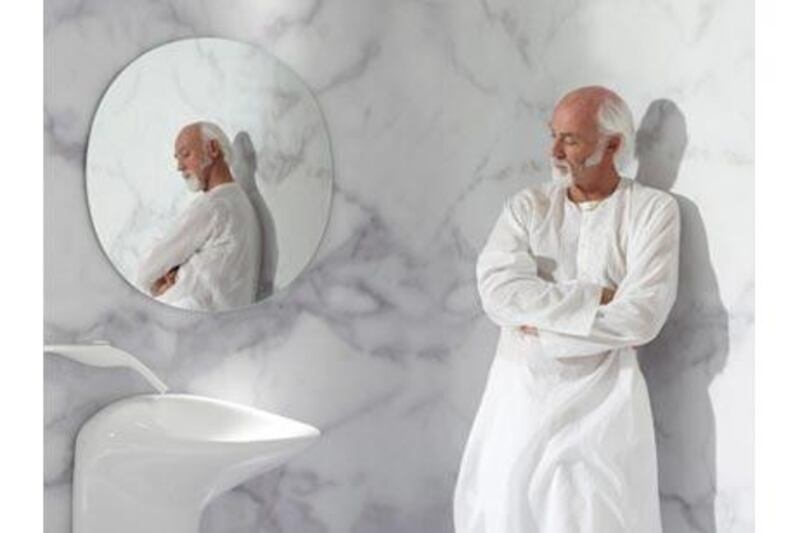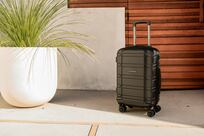"I abhor artificially induced consumerism," declares Ross Lovegrove. His line of thinking pulling no punches, it's ultra-refreshing ... and takes me back to when we first met, about 15 years ago. On that occasion The Design Museum in London had invited design personalities to spend £30,000 (a lot of money in 1993) on "things they would like to live with", reflecting what they found most inspiring. These items would become part of the museum's new Conran Foundation Collection.
I remember being intrigued by Lovegrove's selection. Forget so-called iconic objects; think household marvels - like coat hangers, an Alessi peppermill and Gillette shaving gel. Products that, according to Lovegrove, "embodied the pluralistic aesthetic of our times". According to Lovegrove, design provides the means to tackle current issues and explore the potential that the modern world has to offer. Blurring the boundaries between design, technology and science, he describes himself as a "21st century translator of technology into everyday products" and more evolutionary biologist than designer - as witnessed during his studies, when he chose to document the decomposition of a tomato over three months. He saw charting the state of its change as being highly relevant to design and architecture.
Now aged 51, Lovegrove has always had plenty to say for himself - which he gets away with, thanks to his infectious optimism and charm. His distinctive white hair and beard, contrasting with his designer-ethnic garb, gives him a particularly charismatic and almost spiritual presence. Nicknamed Captain Organic among the international design fraternity, Lovegrove's fluid, tactile designs - which he acknowledges are a nod to the sculpture of Henry Moore and Anish Kapoor - are the fruit of a deep concern for the environment and his constant search for forms that look and feel human. Growing up in Wales, with its craggy coastline and his parents' frugal ways (they never threw things out or replaced them) has strongly influenced him: his overall approach to design is more to do with longevity than simply developing some snazzy new products to outsell a competitor for a few years.
Lovegrove started his career in the early 1980s, fresh from the Royal College of Art in London. He initially worked for Frog Design in Germany, designing computers for Apple and Walkmans for Sony, before moving to Paris to work as a consultant for Knoll, designing the successful Alessandri office system. He later joined the Atelier de Nîmes, alongside Jean Nouvel and Philippe Starck, designing accessories for Louis Vuitton, Hermès and Dupont, among others.
Setting up on his own in 1990, Lovegrove has worked for a veritable who's who of international companies - including Airbus, Kartell, Cappellini, Idee, Moroso, Luceplan, Driade, Peugeot, Apple, Issey Miyake, VitrA, Olympus, Tag Heuer, Herman Miller and Japan Airlines. His designs have been exhibited in museums such as the Centre Pompidou in Paris and New York's MoMA and Cooper-Hewitt, and he has won countless awards, including the World Technology Award for Design, given by Time magazine and CNN in 2005.
Indeed, you might wonder what's left for him to design, but Lovegrove swiftly rattles off his current workload: "I'm working on advanced projects such as Generator House and the Alpine Capsule, a new plastic chair, lighting, a new watch for Issey Miyake, new bathroom products for VitrA. plus a lot of new research with Sharp Solar ..." And future plans? "I'm interested in all aspects of 21st-century new economy potential - so that's creating products that express modernity and a new human age. The car is an important objective but so too would be a solar park for children."
All of this is rooted in his evangelistic passion for what he refers to as organic design, explaining that it has the power to "diffuse the technocracy of contemporary design ... soften and earth our feelings and sense of being ... It can appeal to our deep primordial instincts and move us in a non-linguistic way..." Not everybody sees it so clearly, though: "The problem with industrial design is that it often comes down to a discussion of taste," Lovegrove said in an interview for London's Design Museum in 2007. "A product can be so perfectly modelled with digital technology that you risk the client refusing to produce it simply because they don't like the look of the inanimate model. So there's no debate or dialogue: just a confrontation of taste. It's very frustrating.
"I prefer to have a wonderful idea on paper than a compromised idea realised. I'm just not interested in contaminating this planet with irrelevance." This is what sets Lovegrove apart. Unlike most designers, whose main purpose is to make the latest products ever more seductive, Lovegrove's goal is to use design as an opportunity to examine how we live. He is preoccupied by the way people use objects and how they relate to their belongings, both emotionally and rationally. This was illustrated at TEDGlobal's conference in Oxford, UK, earlier this summer. "I rarely agree with what clients ask me to do ..." he declared, "it's all about finding out what the real problem is ... to push beyond the initial thoughts clients bring you. It takes trust, but design can and should be an evolution of ideas and not a pre-packaged solution ..."
As an example of pushing beyond the obvious, he told the audience how, while working on a project for Japan Airlines, he had proposed a Bonsai tree on every seat. "Instead of their saying no, two months of serious research followed, after which it was solemnly concluded that 'they could not keep bonsai trees alive in a cabin environment'." Known to be provocative - sometimes deliberately - he added: "If you keep a straight face, you can get exactly what you want in Japan."
However, Lovegrove affirms, he was not joking. "The Bonsai tree was a serious attempt to bring a new dimension to the perception of air quality in the cabin environment ... Yes, it was also a provocation in some way, but imagine if they had said 'yes'. How beautiful this small gesture would be in a cultural and physiological sense." He reveals that he took the senior executive board of JAL to Hakone to see Henry Moore's sculpture and to Kyoto to see the moss garden, "in order for them to begin to recognise the power of nature, form and the value of cultural resonance that can be embedded in projects to retain the genesis of their origin ..."
Lovegrove describes his DNA - "design, nature, art" - as what lies at the heart of his "fat-free" design (both his terms). The objects he creates - from cameras to chairs, water bottles to watches - are reduced to their core components, resulting in minimal forms of maximum beauty. Cue his work for the Turkish sanitary ware manufacturer, VitrA. Commissioned to design a bathroom range, naturally that wasn't how Lovegrove saw it. "Designing a bath is not about making an isolated object," he says. "Its about the whole bathing ritual - and Turkey has the centuries-old tradition of the hammam to draw upon." As the name suggests, Freedom breaks away from the predictable with a family of sensual, biomorphic forms, enhanced by surface finish and technical innovation. With over 100 pieces, it is one of the biggest bathroom projects ever by a single designer.
So, having worked extensively all over the world and now preparing for a visit to the UAE, does the Middle East beckon? "I am fascinated and curious ... I think there is incredible opportunity to explore ways to get humans outside without their melting, as well as evolve New World relevant concepts for cities facing change in the face of global warming ..." Lovegrove succeeds in having a high international profile while being able to go to ground when it suits. He takes refuge in his Notting Hill studio, a high-tech cave-cum-mini science museum hidden behind an anonymous facade - or in his futuristic home above the studio, where he lives with his wife Miska, an architect, and their teenage son.
"Sometimes it's important to isolate yourself from the commercial reality of design and focus on examining your own intent - that's what all the great thinkers did," he says. "Trying to stay on the radar by remaining visible isn't really an objective. What you show is where you go, so unless there is something worthwhile to talk about, I think it's better to remain discreet, and a little calm, to reflect on why, how or what you should design."
Ross Lovegrove will be speaking at the World Interior Design Congress, Grand Hyatt, Dubai: November 10-11, www.ifi2009dubai.org; www.rosslovegrove.com. His talk, Organic Design, takes place at 9.45am on November 10.





